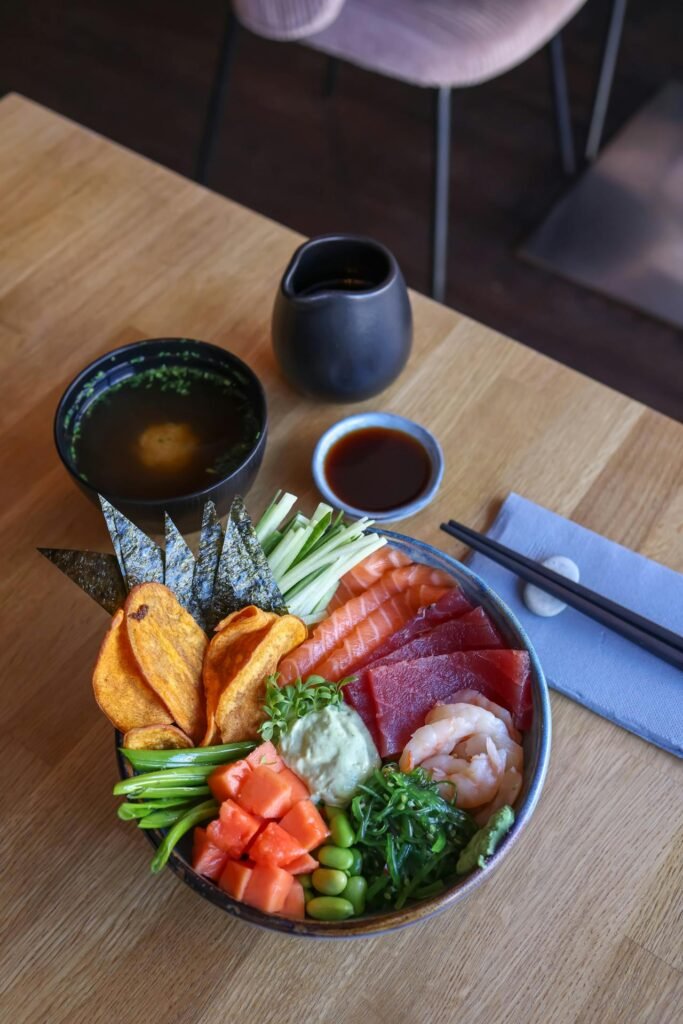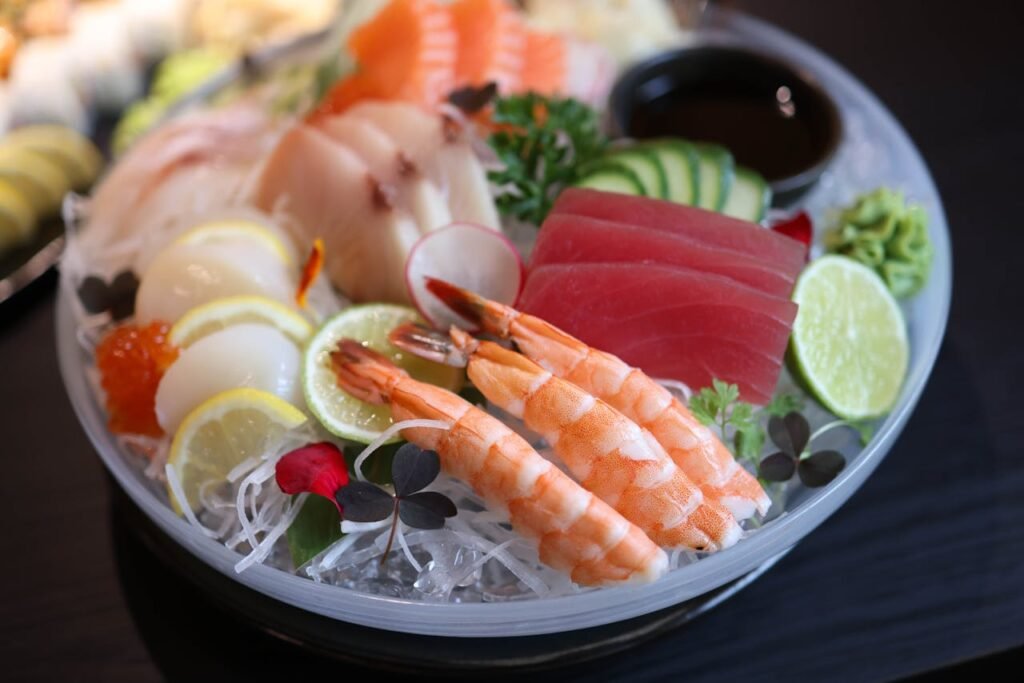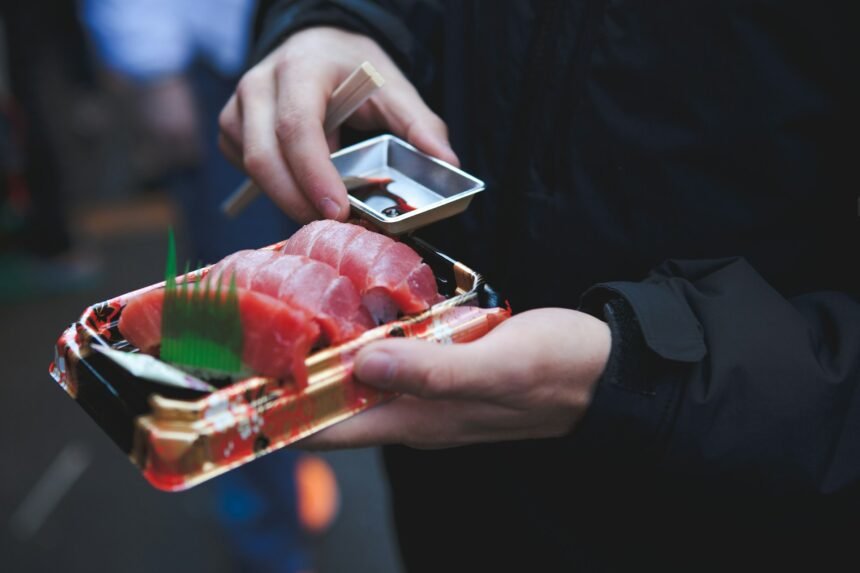When it comes to sushi, the spicy tuna roll is a beloved favourite among enthusiasts worldwide. But for those watching their calorie intake, the question of spicy tuna roll calories often arises. In this comprehensive guide, we’ll dive deep into the world of spicy tuna rolls, exploring their nutritional content, variations, and how they fit into a balanced diet. Whether you’re a sushi aficionado or a health-conscious diner, this article will provide you with all the information you need about spicy tuna roll calories.
Understanding the Basics: What’s in a Spicy Tuna Roll?
Before we delve into the specifics of spicy tuna roll calories, it’s essential to understand what makes up this popular sushi choice. A typical spicy tuna roll consists of:
- Nori (seaweed wrap)
- Sushi rice
- Raw tuna
- Spicy sauce (usually made with mayonnaise and chili sauce)
- Optional ingredients like cucumber or avocado
The combination of these ingredients creates a delightful balance of flavours and textures, but it also contributes to the overall calorie count. Let’s break down each component to better understand the spicy tuna roll calories.
Nori: The Wrapper
Nori, the thin sheet of dried seaweed used to wrap sushi rolls, is surprisingly low in calories. A single sheet of nori typically contains only about 5-10 calories. It’s also rich in minerals like iodine and provides a good source of fibre. When considering spicy tuna roll calories, the nori wrapper contributes minimally to the overall count.
Sushi Rice: The Base
Sushi rice is a significant contributor to the calorie content of a spicy tuna roll. A typical spicy tuna roll contains about 1/2 to 3/4 cup of sushi rice, which can add anywhere from 150 to 225 calories to the roll. The rice is usually seasoned with rice vinegar, sugar, and salt, which adds flavour but also increases the calorie count slightly.
Raw Tuna: The Star Ingredient
Raw tuna is a lean protein source and is relatively low in calories. A typical spicy tuna roll contains about 30-40 grams of tuna, which adds approximately 40-50 calories to the roll. Tuna is also an excellent source of omega-3 fatty acids and provides essential nutrients like vitamin D and selenium.
Spicy Sauce: The Flavour Boost
The spicy sauce is where many of the extra calories in a spicy tuna roll come from. Made primarily with mayonnaise and chili sauce, this component can add anywhere from 50 to 100 calories to the roll, depending on the recipe and amount used.
Optional Ingredients
Some variations of spicy tuna rolls include additional ingredients like cucumber (very low in calories) or avocado (which can add about 50 calories per roll). These additions can affect the overall spicy tuna roll calories, so it’s important to consider them when tracking your calorie intake.
Understanding these components helps us appreciate the complexity of calculating spicy tuna roll calories and sets the stage for a more detailed nutritional analysis.

Breaking Down the Numbers: Spicy Tuna Roll Calories and Nutritional Content
Now that we’ve examined the individual components, let’s look at the overall nutritional profile of a typical spicy tuna roll. Keep in mind that these numbers can vary depending on the size of the roll and the specific recipe used.
Average Calorie Count
On average, a single spicy tuna roll (6-8 pieces) contains approximately 290-350 calories. This can vary depending on the size of the roll and the specific ingredients used. For those tracking spicy tuna roll calories, it’s important to note that restaurant portions may be larger and thus higher in calories than homemade versions.
Macronutrient Breakdown
Understanding the macronutrient composition of a spicy tuna roll can help you fit it into your dietary plan. Here’s a typical breakdown:
- Carbohydrates: 40-50 grams (primarily from the sushi rice)
- Protein: 10-15 grams (mainly from the tuna)
- Fat: 5-10 grams (from the spicy mayo sauce and tuna)
This balance of macronutrients makes the spicy tuna roll a relatively well-rounded meal option, despite its compact size.
Micronutrients and Health Benefits
While spicy tuna roll calories are often the primary focus for health-conscious diners, it’s worth noting the various micronutrients and health benefits this sushi choice offers:
- Omega-3 fatty acids: Tuna is rich in these heart-healthy fats.
- Vitamin D: Tuna provides a good source of this essential vitamin.
- Iodine: The nori wrapper is an excellent source of this important mineral.
- Selenium: Tuna is high in selenium, which supports thyroid function.
These nutritional benefits can make the spicy tuna roll a valuable part of a balanced diet, provided the calorie content fits within your daily goals.
Understanding the full nutritional profile of spicy tuna rolls helps put the calorie content into perspective. While spicy tuna roll calories are important to consider, the overall nutritional value of this sushi choice makes it a potentially healthy option when consumed in moderation.
Comparing Spicy Tuna Roll Calories to Other Sushi Choices
To truly understand how spicy tuna roll calories stack up, it’s helpful to compare them to other popular sushi choices. This comparison can aid in making informed decisions when ordering sushi, especially for those mindful of their calorie intake.
Popular Sushi Rolls and Their Calorie Counts
Let’s look at some common sushi rolls and their approximate calorie counts:
- California Roll: 250-300 calories
- Salmon Avocado Roll: 300-350 calories
- Eel Avocado Roll: 370-420 calories
- Philadelphia Roll: 320-370 calories
- Rainbow Roll: 400-450 calories
- Shrimp Tempura Roll: 450-500 calories
As we can see, spicy tuna roll calories (290-350) fall somewhere in the middle of this range. They’re generally higher in calories than simpler rolls like California rolls but lower than more elaborate choices like rainbow rolls or tempura-based options.
Factors Influencing Calorie Content
Several factors can influence the calorie content of sushi rolls, including:
- Size of the roll
- Amount and type of fish or seafood used
- Presence of high-calorie ingredients like avocado or cream cheese
- Use of tempura or other fried elements
- Amount of rice used
These factors explain why spicy tuna roll calories can vary and why they might differ from other seemingly similar rolls.
Making Informed Choices
When comparing spicy tuna roll calories to other sushi options, consider the following:
- Opt for rolls with lean proteins and vegetables if you’re looking for lower-calorie options.
- Be cautious of rolls with tempura, as these are typically higher in calories and fat.
- Consider ordering sashimi (just the fish without rice) for a low-calorie, high-protein option.
- Remember that specialty rolls with multiple types of fish or added toppings will generally be higher in calories.
By understanding how spicy tuna roll calories compare to other sushi choices, you can make more informed decisions that align with your dietary goals while still enjoying your sushi experience.
The Impact of Preparation Methods on Spicy Tuna Roll Calories
The way a spicy tuna roll is prepared can significantly impact its calorie content. Understanding these variations can help you make more informed choices when ordering or preparing spicy tuna rolls at home.
Restaurant vs. Homemade Spicy Tuna Rolls
Restaurant-prepared spicy tuna rolls often contain more calories than their homemade counterparts. This is due to several factors:
- Portion sizes: Restaurant rolls are often larger, containing more rice and filling.
- Generous use of spicy mayo: Restaurants may use more sauce to enhance flavour.
- Additional ingredients: Some restaurants add extra components like tempura flakes.
On average, a restaurant-prepared spicy tuna roll might contain 50-100 more calories than a homemade version.
Variations in Spicy Sauce
The spicy sauce used in tuna rolls can vary greatly, affecting the overall spicy tuna roll calories:
- Traditional spicy mayo: Made with mayonnaise and sriracha, this version is higher in calories.
- Lighter versions: Some recipes use Greek yogurt or light mayo to reduce calories.
- Oil-based sauces: Some chefs use a blend of oils and spices, which can be lower in calories but higher in fat.
The type and amount of sauce used can add anywhere from 30 to 100 calories to your spicy tuna roll.
The Role of Additional Ingredients
Many variations of spicy tuna rolls include extra ingredients that can significantly impact the calorie count:
- Avocado: Adds about 50 calories per roll but provides healthy fats.
- Cucumber: A low-calorie addition that adds crunch without many calories.
- Tempura flakes: Can add 30-50 calories and increase the fat content.
- Cream cheese: Significantly increases calories and fat content.
When considering spicy tuna roll calories, it’s crucial to account for these additional ingredients.
Cooking Methods
While traditional spicy tuna rolls use raw fish, some variations involve cooking methods that can affect the calorie content:
- Seared tuna: Slightly increases calories due to added oil.
- Tempura-fried rolls: Significantly increases calories and fat content.
- Baked rolls: Can add calories depending on the ingredients used in baking.
Understanding these preparation methods can help you make choices that align with your dietary goals when it comes to spicy tuna roll calories.
By being aware of how different preparation methods impact spicy tuna roll calories, you can make more informed choices whether you’re dining out or preparing sushi at home. Remember, small changes in ingredients or preparation can make a significant difference in the overall calorie content of your spicy tuna roll.
Incorporating Spicy Tuna Rolls into a Balanced Diet
Despite their calorie content, spicy tuna rolls can be part of a healthy, balanced diet when consumed mindfully. Here’s how you can enjoy this popular sushi choice while maintaining your nutritional goals.
Portion Control
One of the key factors in managing spicy tuna roll calories is portion control. Consider these strategies:
- Order a half roll instead of a full roll.
- Share a roll with a friend.
- Pair a spicy tuna roll with lower-calorie options like sashimi or a cucumber roll.
Remember, a typical restaurant serving of 6-8 pieces can be more than one portion for some individuals.
Balancing Your Plate
When enjoying spicy tuna rolls, balance your meal by including:
- A serving of vegetables (e.g., edamame or a side salad)
- Miso soup for added nutrients and satiety
- Green tea, which may help boost metabolism
This approach ensures you’re getting a range of nutrients while managing your spicy tuna roll calories.
Frequency of Consumption
While spicy tuna rolls can be part of a healthy diet, they shouldn’t be an everyday food for most people. Consider:
- Limiting sushi meals to once or twice a week
- Alternating between spicy tuna rolls and lower-calorie sushi options
- Saving spicy tuna rolls for special occasions if you’re strictly monitoring calorie intake
Modifications for Lower Calories
If you’re looking to reduce the spicy tuna roll calories in your meal, consider these modifications:
- Ask for less rice or brown rice instead of white rice.
- Request the spicy sauce on the side so you can control the amount.
- Choose rolls with added vegetables instead of high-calorie ingredients like avocado or cream cheese.
Complementary Lifestyle Factors
To balance out the calories from spicy tuna rolls, consider:
- Increasing your physical activity on days you plan to eat sushi
- Adjusting your calorie intake in other meals to accommodate the spicy tuna roll calories
- Staying hydrated, as sometimes thirst can be mistaken for hunger
By implementing these strategies, you can enjoy spicy tuna rolls as part of a balanced diet without compromising your health goals. Remember, no single food is inherently “good” or “bad” – it’s all about how it fits into your overall dietary pattern and lifestyle.

Do spicy tuna rolls provide any nutritional benefits?
Yes, they offer protein, omega-3 fatty acids, and various vitamins and minerals.
How many calories are in a typical spicy tuna roll?
A standard restaurant spicy tuna roll contains about 290-350 calories.
Can spicy tuna rolls fit into a weight loss diet?
Yes, if consumed in moderation and balanced with other nutritious foods.
Are homemade spicy tuna rolls healthier?
Often, yes. Homemade rolls allow control over ingredients and portions.
Health Considerations Beyond Calories
While spicy tuna roll calories are an important consideration for many, there are other health factors to keep in mind when enjoying this popular sushi choice. Let’s explore some of these considerations to get a more comprehensive view of how spicy tuna rolls fit into a healthy lifestyle.
Mercury Content in Tuna
One of the primary health concerns associated with tuna consumption is its mercury content. Mercury is a heavy metal that can accumulate in the body and potentially cause health issues. Here are some key points to consider:
- Tuna species vary in mercury content: Bluefin and bigeye tuna typically have higher levels than skipjack or yellowfin.
- Frequency matters: The FDA recommends limiting albacore tuna to once per week for most adults.
- Pregnant women and children should be especially cautious and follow specific guidelines for tuna consumption.
While the mercury in an occasional spicy tuna roll is unlikely to cause issues for most people, it’s something to be aware of if you consume tuna frequently.
Sodium Content
Sushi, including spicy tuna rolls, can be high in sodium due to ingredients like soy sauce. High sodium intake can contribute to high blood pressure and other health issues. Consider:
- Using low-sodium soy sauce or limiting the amount
- Balancing your sodium intake throughout the day when you plan to eat sushi
- Drinking plenty of water to help flush excess sodium from your system
Raw Fish Safety
Spicy tuna rolls typically contain raw fish, which carries a small risk of foodborne illness. To minimize this risk:
- Choose reputable sushi restaurants with high hygiene standards
- Be cautious if you have a compromised immune system, are pregnant, or are elderly
- Consider fully cooked alternatives if you’re particularly concerned about raw fish consumption
Potential Allergens
Spicy tuna rolls contain several common allergens:
- Fish (tuna)
- Soy (in soy sauce)
- Wheat (in soy sauce and sometimes in the spicy sauce)
- Eggs (in mayonnaise-based spicy sauces)
If you have food allergies, always inquire about ingredients and potential cross-contamination.
Nutritional Benefits
Despite these considerations, spicy tuna rolls offer several nutritional benefits:
- High-quality protein from the tuna
- Omega-3 fatty acids, which support heart and brain health
- Iodine from the nori wrapper, essential for thyroid function
- Various vitamins and minerals, including vitamin D and selenium
When considering spicy tuna roll calories, it’s important to balance this with the overall nutritional profile and potential health impacts. By being aware of these factors, you can make informed decisions about including spicy tuna rolls in your diet in a way that supports your overall health and wellness goals.
Making Healthier Spicy Tuna Rolls at Home
For those who love spicy tuna rolls but want more control over the ingredients and spicy tuna roll calories, making them at home can be a great option. Here’s a guide to creating healthier versions of this popular sushi choice in your own kitchen.
Ingredients for a Healthier Spicy Tuna Roll
Start with these healthier ingredient choices:
- Brown rice instead of white rice for added fibre
- Fresh, sushi-grade tuna from a reputable source
- Nori sheets (seaweed wraps)
- Greek yogurt as a base for the spicy sauce instead of mayonnaise
- Sriracha or other hot sauce for spice
- Optional: cucumber or carrots for added crunch and nutrients
Healthier Spicy Sauce Recipe
Create a lighter spicy sauce with these steps:
- Mix 2 tablespoons of Greek yogurt with 1 teaspoon of sriracha
- Add a dash of rice vinegar and a pinch of sugar to balance flavours
- Adjust spiciness to taste
This version significantly reduces the calories compared to traditional mayo-based sauces.
Step-by-Step Preparation
Follow these steps for a healthier spicy tuna roll:
- Cook brown rice according to package instructions and let it cool
- Mix diced tuna with your homemade spicy sauce
- Lay out a sheet of nori on a bamboo mat
- Spread a thin layer of brown rice on the nori, leaving a strip at the top edge
- Place a line of the spicy tuna mixture across the centre of the rice
- Add thin strips of cucumber or carrot if desired
- Using the bamboo mat, roll the nori tightly around the filling
- Seal the edge with a bit of water
- Slice the roll into 6-8 pieces using a sharp, wet knife
Calorie Comparison
By making these healthier substitutions, you can significantly reduce the spicy tuna roll calories:
- Traditional restaurant spicy tuna roll: 290-350 calories
- Homemade healthier version: approximately 200-250 calories
This reduction in calories comes primarily from using brown rice, Greek yogurt-based sauce, and controlling portion sizes.
Tips for Perfect Homemade Rolls
- Use slightly warm rice for easier spreading
- Wet your hands to prevent rice from sticking while rolling
- Don’t overfill the rolls, as this can make them difficult to seal
- Experiment with different vegetables for added nutrition and variety
By making spicy tuna rolls at home, you have full control over the ingredients and portion sizes, allowing you to enjoy this sushi favourite while managing your calorie intake more effectively.
The Role of Spicy Tuna Rolls in Different Diets
Spicy tuna rolls can fit into various dietary patterns, but the approach may differ depending on your specific nutritional goals. Let’s explore how spicy tuna roll calories can be incorporated into different diets.
Low-Carb and Keto Diets
For those following low-carb or ketogenic diets, traditional spicy tuna rolls may be too high in carbohydrates due to the rice content. However, there are ways to enjoy the flavours while keeping carbs low:
- Naruto rolls: Use thin cucumber slices instead of rice to wrap the spicy tuna
- Sashimi-style: Enjoy the spicy tuna mixture without rice or nori
- Cauliflower rice: Substitute cauliflower “rice” for sushi rice
These modifications can significantly reduce the carbohydrate content and overall spicy tuna roll calories.
High-Protein Diets
Spicy tuna rolls can be a good fit for high-protein diets:
- A typical roll contains 10-15 grams of protein
- Increase protein content by adding more tuna or incorporating other protein sources like edamame
Remember to balance the spicy tuna roll calories with other protein sources throughout the day.
Pescatarian and Flexitarian Diets
Spicy tuna rolls are an excellent option for those who include fish in their primarily plant-based diets:
- Provides essential nutrients like omega-3 fatty acids
- Offers a tasty way to incorporate seafood into the diet
- Can be paired with vegetable-based sushi for a balanced meal
Calorie-Controlled Diets
For those on calorie-controlled diets, spicy tuna rolls can be included but portion control is key:
- Stick to one roll (6-8 pieces) as part of a balanced meal
- Pair with low-calorie options like miso soup and edamame
- Consider hand rolls or smaller portions to reduce overall spicy tuna roll calories
Gluten-Free Diets
While rice is gluten-free, other components of spicy tuna rolls may contain gluten:
- Check that soy sauce is gluten-free (or use tamari)
- Ensure the spicy sauce doesn’t contain any gluten-containing ingredients
- Be cautious of cross-contamination in restaurants
By making these considerations, individuals on gluten-free diets can safely enjoy spicy tuna rolls.
Understanding how spicy tuna rolls fit into different dietary patterns allows you to enjoy this sushi favourite while adhering to your specific nutritional needs and goals.

The Cultural Significance of Spicy Tuna Rolls
While we’ve focused heavily on spicy tuna roll calories and nutritional aspects, it’s worth exploring the cultural significance of this popular sushi choice. Understanding its origins and place in culinary tradition can enhance your appreciation of the dish.
Origins of the Spicy Tuna Roll
Interestingly, the spicy tuna roll is not a traditional Japanese creation. It’s believed to have originated in Los Angeles in the 1980s as a way to use up less desirable parts of the tuna and appeal to American palates that favoured spicier flavours.
Fusion Cuisine
The spicy tuna roll represents a perfect example of fusion cuisine:
- Combines traditional Japanese sushi-making techniques
- Incorporates Western flavours (spicy mayo)
- Reflects the adaptability of cuisine to local tastes
This fusion aspect has contributed to its widespread popularity and the variation in spicy tuna roll calories across different recipes and regions.
Impact on Sushi Culture
The invention and popularity of the spicy tuna roll have had significant impacts:
- Increased accessibility of sushi to a wider audience
- Inspired countless other fusion sushi rolls
- Changed perceptions of what constitutes “authentic” sushi
Sustainability Concerns
The popularity of spicy tuna rolls has also raised concerns about tuna sustainability:
- Increased demand for tuna has led to overfishing of certain species
- Some sushi restaurants are now using more sustainable tuna options or alternatives
When enjoying spicy tuna rolls, consider asking about the source of the tuna and opting for more sustainable choices when possible.
Understanding the cultural context of spicy tuna rolls adds depth to your sushi experience beyond just considering spicy tuna roll calories. It allows you to appreciate the dish as a culinary innovation that bridges cultures and continues to evolve.
Conclusion: Enjoying Spicy Tuna Rolls Mindfully
As we wrap up our comprehensive guide to spicy tuna roll calories, it’s clear that this popular sushi choice can be part of a healthy diet when consumed mindfully. Let’s recap the key points:
- Spicy tuna roll calories typically range from 290-350 per roll, but can vary based on ingredients and preparation methods.
- The nutritional profile of spicy tuna rolls includes a balance of carbohydrates, proteins, and fats, along with beneficial micronutrients.
- Homemade versions can be tailored to reduce calories and increase nutritional value.
- Portion control and balance with other foods are key to incorporating spicy tuna rolls into various diets.
- Consider health factors beyond calories, such as mercury content and food safety.
- Appreciate the cultural significance and fusion aspect of spicy tuna rolls.
By being informed about spicy tuna roll calories and nutritional content, you can make choices that align with your health goals while still enjoying this delicious sushi option. Remember, moderation is key, and spicy tuna rolls can be part of a varied, balanced diet.
Whether you’re indulging in a restaurant-made spicy tuna roll or crafting a healthier version at home, savour each bite and appreciate the blend of flavours and textures. After all, enjoying your food is an important part of a healthy relationship with eating.
So the next time you’re faced with a menu of sushi options, you’ll be well-equipped to make an informed decision about spicy tuna rolls. Enjoy your sushi experience with both pleasure and mindfulness!
Table: Spicy Tuna Roll Nutritional Comparison
| Type of Roll | Calories | Carbs (g) | Protein (g) | Fat (g) |
|---|---|---|---|---|
| Traditional Restaurant Roll | 290-350 | 40-50 | 10-15 | 5-10 |
| Homemade Healthier Version | 200-250 | 30-40 | 10-15 | 3-7 |
| Low-Carb Version (No Rice) | 100-150 | 2-5 | 15-20 | 5-10 |
FAQs About Spicy Tuna Roll Calories
- How many calories are in a typical spicy tuna roll?
A typical restaurant-served spicy tuna roll contains approximately 290-350 calories. - Can I eat spicy tuna rolls if I’m on a diet?
Yes, spicy tuna rolls can be part of a balanced diet. Focus on portion control and balance with other nutritious foods. - Are homemade spicy tuna rolls healthier?
Homemade rolls can be healthier as you have control over ingredients and portions, potentially reducing spicy tuna roll calories. - How often can I eat spicy tuna rolls?
For most people, enjoying spicy tuna rolls once or twice a week as part of a balanced diet is reasonable. - Are there low-carb options for spicy tuna rolls?
Yes, you can enjoy spicy tuna without rice, wrapped in cucumber, or as sashimi for a low-carb option.






